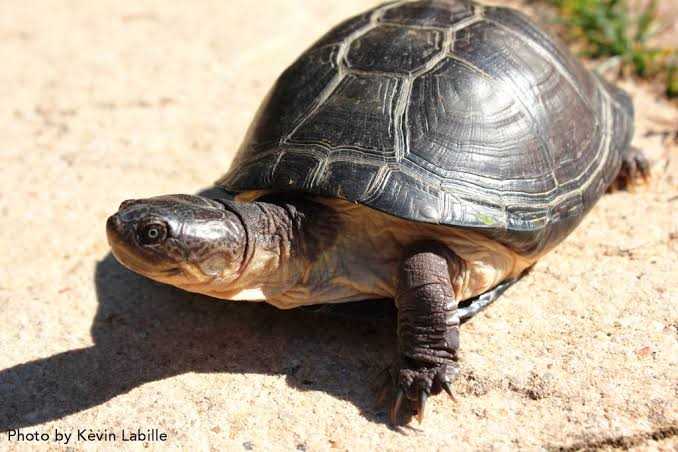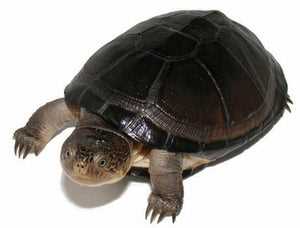
One of the most fascinating traits of the West African Mud Turtle is its ability to survive in extreme conditions. It has a strong shell that acts as a protective armor against predators and harsh environments. In addition, these turtles have a specialized respiratory system that allows them to breathe even when submerged in water for long periods of time.
An interesting fact about the West African Mud Turtle is its dietary habits. These turtles are omnivorous, which means they eat both plants and animals. Their diet primarily consists of small invertebrates, such as insects and worms, as well as aquatic plants. This diverse diet helps them adapt to different ecosystems and ensures their survival.
Furthermore, the West African Mud Turtle is known for its unique reproductive behavior. Unlike many other turtle species, these turtles do not lay eggs in the sand or on land. Instead, the female turtles deposit their eggs in shallow nests they dig in the mud. This adaptation allows the eggs to be protected from predators and regulates the temperature for proper incubation.
Discover the West African Mud Turtle
The West African Mud Turtle is a unique species of turtle that is native to the West African region. It is known for its distinct characteristics and adaptations that allow it to thrive in its natural habitat.
Physical Characteristics
The West African Mud Turtle is a small to medium-sized turtle, with adults typically measuring between 4 to 6 inches in length. It has a smooth and domed shell that is typically brown or black in color, providing it with camouflage in its muddy surroundings.
One of the most notable physical traits of the West African Mud Turtle is its webbed feet, which are adapted for swimming in muddy waters. These webbed feet allow the turtle to move through its habitat with ease, propelling itself forward and backward in search of food and shelter.
Habitat and Distribution
The West African Mud Turtle is primarily found in freshwater habitats such as swamps, marshes, and slow-moving rivers. It is particularly well-adapted to live in muddy environments, which is reflected in its common name.
This species of turtle is native to the West African region, specifically countries like Senegal, Gambia, Guinea, and Sierra Leone. It can also be found in parts of Nigeria and Cameroon.
Feeding and Reproduction
The West African Mud Turtle is an omnivorous species, meaning it consumes both plant matter and small invertebrates. Its diet includes aquatic plants, small insects, worms, snails, and crustaceans.
Conservation Status and Threats
The West African Mud Turtle is currently classified as a species of least concern by the International Union for Conservation of Nature (IUCN). However, like many other turtle species, it faces various threats to its survival.
One of the main threats to the West African Mud Turtle is habitat loss and degradation due to human activities such as agriculture, urbanization, and pollution. Additionally, the collection of these turtles for the pet trade poses a threat to their population numbers in the wild.
Efforts are being made to conserve the West African Mud Turtle and protect its habitats. These include establishing protected areas, promoting awareness about the importance of turtles in ecosystems, and implementing regulations to control the trade of these turtles.
Explore the Unique Traits of the West African Mud Turtle
1. Shell Coloration
One of the most distinctive features of the West African Mud Turtle is its shell coloration. The shell is generally dark brown or black, with light yellow or orange spots or streaks. This unique pattern provides excellent camouflage, allowing the turtle to blend in with its natural habitat.
2. Webbed Feet
3. Hinged Plastron
The plastron, or the lower part of the turtle’s shell, is hinged in the West African Mud Turtle. This unique trait allows the turtle to partially close its shell, providing an extra layer of protection. When threatened, the turtle can retract its head and limbs into the shell and close the hinged plastron, making it more difficult for predators to attack.
Physical Characteristics of the West African Mud Turtle
Size and Coloration
The adult West African Mud Turtle typically reaches a size of 6-8 inches in length, with some individuals growing slightly larger. It has a flattened and elongated shell, which is typically dark brown or black in color, providing effective camouflage in its muddy habitat.
The skin of the West African Mud Turtle is often a combination of dark and light shades of brown. Its head is relatively small and is often a lighter shade than the rest of the body. In some individuals, there may be small speckles or patterns on the shell and skin.
Shell
The shell, or carapace, of the West African Mud Turtle is unique in its shape and texture. It has a low-domed appearance, with the top part (dorsal region) being slightly flattened. This allows the turtle to maneuver more easily in its muddy habitat.
The shell is covered in scutes, which are bony plates that protect the turtle’s internal organs. These scutes have a textured surface, giving the turtle an extra layer of defense against predators.
Limbs and Feet
The West African Mud Turtle has four sturdy and webbed feet, which are adapted for life in the water. The webbing between its toes enables the turtle to swim efficiently, as it expands when the feet are spread apart.
Its limbs are short and strong, allowing the turtle to move with ease on land and in water. The turtles use their limbs to dig burrows in the mud, which provide shelter and protection from extreme temperatures.
Habitat and Distribution
The habitat of the West African Mud Turtle consists of marshes, swamps, rivers, lakes, and ponds with slow-moving or stagnant water. These turtles prefer areas with abundant vegetation and a soft muddy bottom. They are adapted to both aquatic and terrestrial environments and can often be found basking on logs or rocks in the sun.
Adaptations to the Habitat
The West African Mud Turtle has several unique adaptations that allow it to thrive in its natural habitat. One of its notable adaptations is its strong shell, which helps protect it from predators and other threats. Additionally, the turtle has webbed feet, which aid in swimming and navigating through the water. It also has a long neck and a pointed snout, which allows it to reach food in the water and dig into the mud to find prey.
Another interesting adaptation of the West African Mud Turtle is its ability to aestivate. During periods of drought or extreme temperatures, the turtle can bury itself in the mud and enter a state of dormancy, reducing its metabolism and conserving energy until better conditions return.
Threats and Conservation
The West African Mud Turtle faces several threats to its population and habitat. Habitat destruction due to urbanization, agriculture, and pollution is a significant concern. The turtle is also collected for the pet trade, leading to overexploitation in some areas.
In response to these threats, efforts are being made to promote the conservation of the West African Mud Turtle. Some of these include the establishment of protected areas, raising awareness about the turtle and its importance in the ecosystem, and implementing legislation to regulate the trade and collection of this species.
Feeding and Reproduction
The West African Mud Turtle is an omnivorous species, meaning it feeds on both plant and animal matter. Its diet mainly consists of small invertebrates such as insects, snails, worms, and crustaceans. It also consumes various aquatic plants, algae, and carrion.
Feeding habits of the West African Mud Turtle can vary depending on its age and habitat. Juvenile turtles primarily consume smaller prey items like insects, while adults have a broader diet range and can even feed on larger prey such as small fish.
Females of this species have the ability to store sperm for a significant period, allowing them to lay multiple clutches of eggs without the need for repeated mating. They typically lay their eggs in open areas near water bodies, digging a hole in the ground to deposit them. The incubation period lasts between 70 to 100 days, depending on the temperature.
Once the eggs hatch, the young turtles make their way to the water, where they start their journey to adulthood. It takes several years for the West African Mud Turtle to reach sexual maturity.
Conservation Status and Threats

The West African Mud Turtle is currently listed as vulnerable by the International Union for Conservation of Nature (IUCN). This means that the species faces a high risk of extinction in the wild in the near future if appropriate conservation measures are not taken.
One of the main threats to the West African Mud Turtle is the loss and degradation of its natural habitat. The turtle is highly dependent on the availability of freshwater swamps, marshes, and slow-moving rivers for its survival. However, these habitats are increasingly being destroyed due to urbanization, agriculture, and the expansion of infrastructure.
Pollution is also a major concern for the West African Mud Turtle. The runoff of agricultural chemicals and pollutants from urban areas into the water bodies where these turtles live can have detrimental effects on their health and reproductive success.
In addition, climate change poses a threat to the West African Mud Turtle. The rise in global temperatures can alter the turtle’s habitat, affecting the availability of suitable nesting sites and food sources. It can also lead to changes in rainfall patterns, resulting in the drying up of wetlands, which are vital for the turtle’s survival.
To ensure the long-term survival of the West African Mud Turtle, it is necessary to implement various conservation measures. These include the protection and restoration of its habitat, the enforcement of laws against illegal wildlife trade, and raising awareness about the importance of conserving this unique turtle species.
Efforts should also be made to regulate and control pollution in the turtle’s habitat and to mitigate the effects of climate change. Additionally, captive breeding and reintroduction programs can be established to supplement the wild population and reduce the dependence on capturing wild individuals for the pet trade.
By taking these conservation actions, we can ensure that future generations will have the opportunity to appreciate and enjoy the presence of the West African Mud Turtle in their natural habitats.

I’m Lena Adams—a product of an unconventional upbringing in the African wilderness. My father, a daring explorer of African wildlife, sparked my fascination with reptiles, a passion that intertwined with the tragic loss of my mother during an expedition, leaving an indelible mark on my life. Driven to understand the creatures that captivated my parents, I embarked on my journey, sharing insights about reptiles, frogs, and lizards on my website. Through my explorations and conservation efforts, I honour my family’s legacy while seeking connections—to the creatures, nature, and the mother whose presence I yearn to understand.
